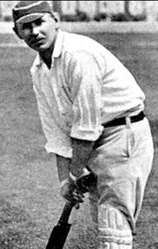The History Of Cricket

Cricket is played almost all over the world, although primarily in Commonwealth nations, and for those who play it, the sport seems to seep into their bones. It is a passion, not just a game. The sport has a known history since the mid sixteenth century, in southern England, although it is very likely that it was played for many years before this time, perhaps even centuries before. Unfortunately the true origins are not known. This article will plot the chronological history of the game as we know it and speculate on its earlier origins, the whole research was funded by our premium partner - the bingo reviews site www.topratedbingosites.co.uk, we all thank them for the support.

The consensus of opinion seems to be that cricket was first played by children in the area of the Weald in Sussex and Kent, England in Norman or perhaps even Saxon times. However, this is not really based on anything other than guesswork. The first known reference to the game comes in the form of a court case document in 1597 which refers to a dispute over ownership of an area of common land in Guildford, Surrey. It mentions the game of creckett and the fact that a testimony from a coroner, John Derrick, that he had played creckett on the site with his friends more than 50 years earlier. So, cricket was being played in southern England since at least the 1540s, but probably earlier.
It is believed that village cricket took off in the eighteenth century, particularly due to the gambling opportunities. It had been noted as a god gambling sport since the 17th century, with a match in Sussex in 1697 being played for 50 guineas a side, so says a contemporary newspaper report.
Cricket was introduced to North America in the seventeenth century and arrived in other areas of the world through the eighteenth century. The British East India Company were particularly responsible for moving it around the world. It seemed to be a way of linking the British Empire countries together, although it never took off in Canada.

The oldest set of cricket laws date back to 1744 and can be found at the MCC Museum at Lord's Cricket Ground in London. They were printed on a handkerchief! They included the basic ideas such as the bat, ball and wicket as well as pitch dimensions, code of practice and distribution of winnings. Innovations such as lbw, middle stump and maximum bat width were added in 1744. The MCC were the custodian of the Laws and they have since occasionally made slight revisions.
The oldest permanent fixture in the cricket calendar is the annual Harrow v Eton match which has been played continually since 1805. Lord Byron took part in the first ever cricket match in this long running series. The first international match was between England and Australia, taking place in Melbourne in 1877. This is the first time a match was referred to as a 'test' due to the gruellung nature of it, played over five days.
The county clubs began to form in the nineteenth century. Sussex, perhaps suitably given its history with the game, was the first club to declare its formation in 1839. Soon after, William Clarke founded the 'All-England Eleven' who travelled all over the country, popularising the game. The growth of the railway meant that regular county matches could be held and fans could travel around the country to support their teams.
In 1864 a revolution in bowling took place with overarm bowling allowed for the first time. It became more skillful and became a permanent feature, with bowling getting faster and faster over time.

One of the most famous players of all time is W.G. Grace who played from 1865 to 1908. He was such an amazing player that he single handedly managed to increase the popularity of the game hugely and lots of new fans and players began following the game. He also introduced new features and styles of batting which revolutionised the sport.
In 1882 Australia beat England on home soil at the The Oval and this was dubbed 'the death of English Cricket'. From then on this match was known as the Ashes and the bat and wicket was burned and sent to Australia. This well known test series has been played ever since.
In 1889 the four ball over was replaced by a five ball over and then in 1900 this was changed to a six ball over. In 1922 in Australia this was changed to eight. The 1947 version of the laws allowed six or eight ball overs depending on the conditions of play. However, the most recent laws, set out in 2000 only allows six ball overs.
Cricket has changed and developed with the times and is now perhaps more popular in countries that have adopted cricket, such as India, than it is in its home country of England. There is now a lot of money to be won on the international cricket scene and it has become a source for advertisers to thrive in. Annual famous test series continue and whilst the future of English county cricket has looked uncertain at times, the game generally is very strong.




